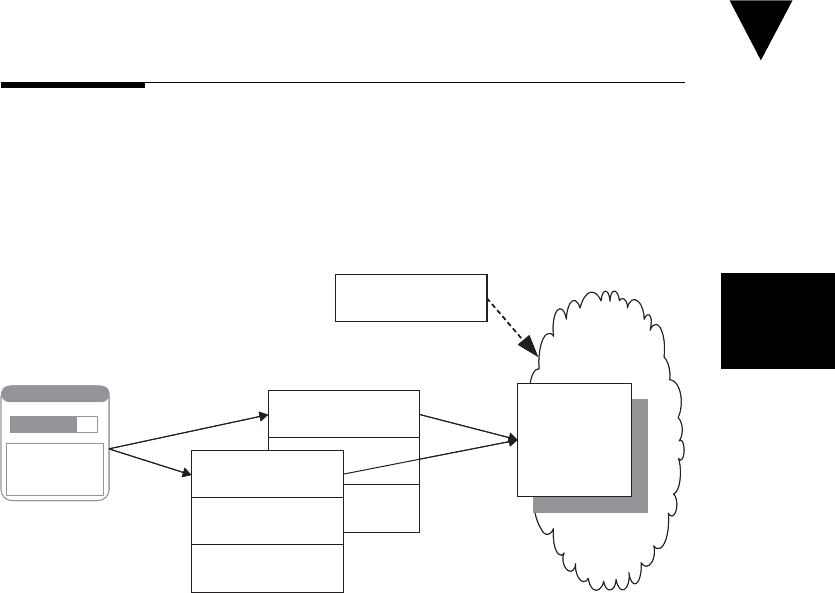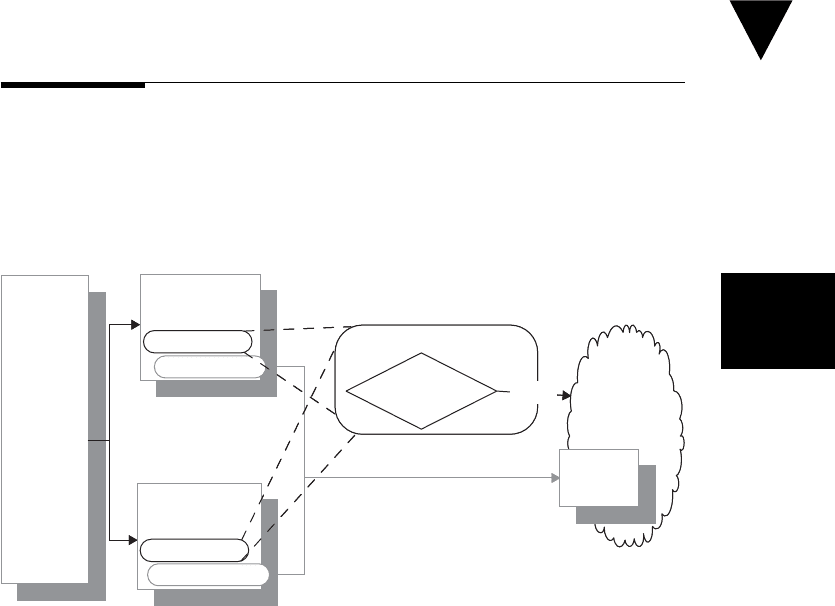Meszaros G. xUnit Test Patterns Refactoring Test Code
Подождите немного. Документ загружается.


428
Flight flight;
public void setUp() throws Exception{
super.setUp();
departureAirport = new Airport("Calgary", "YYC");
destinationAirport = new Airport("Toronto", "YYZ");
BigDecimal flightNumber = new BigDecimal("999");
flight = new Flight( flightNumber , departureAirport,
destinationAirport);
}
public void testGetStatus_initial() {
// implicit setup
// exercise SUT and verify outcome
assertEquals(FlightState.PROPOSED, flight.getStatus());
}
public void testGetStatus_cancelled() {
// implicit setup partially overridden
flight.cancel();
// exercise SUT and verify outcome
assertEquals(FlightState.CANCELLED, flight.getStatus());
}
This approach has several disadvantages, which arise because we are not
organizing our Test Methods around a Testcase Class per Fixture. (We are using
Testcase Class per Feature here.) All the Test Methods on the Testcase Class
must be able to make do with the same fi xture (at least as a starting point), as
evidenced by the partially overridden fi xture setup in the second test in the exam-
ple. The fi xture is also not very obvious in these tests. Where does the fl ight come
from? Is there anything special about it? We cannot even rename the instance
variable to communicate the nature of the fl ight better because we are using it to
hold fl ights with different characteristics in each test.
Implicit
Setup
Chapter 20 Fixture Setup Patterns

429
Prebuilt Fixture
How do we cause the Shared Fixture to be built before the fi rst
test method that needs it?
We build the Shared Fixture separately from running the tests.
When we choose to use a Shared Fixture (page 317), whether it be for reasons
of convenience or out of necessity, we need to create the Shared Fixture before
we use it.
How It Works
We create the fi xture sometime before running the test suite. We can create the
fi xture a number of different ways that we’ll discuss later. The most important
point is that we don’t need to build the fi xture each time the test suite is run
because the fi xture outlives both the mechanism used to build it and any one
test run that uses it.
When to Use It
We can reduce the overhead of creating a Shared Fixture each time a test suite is
run by creating the fi xture only occasionally. This pattern is especially appropri-
ate when the cost of constructing the Shared Fixture is extremely high or cannot
be automated easily.
Setup
Exercise
Verify
Teardown
Fixture
Exercise
Verify
Teardown
SUT
Test Runner
Setup
Setup
Exercise
Verify
Teardown
Fixture
Exercise
Verify
Teardown
SUT
Test Runner
Setup
Also known as:
Prebuilt
Context, Test
Bed
Prebuilt Fixture
Prebuilt
Fixture

430
Because of the Manual Intervention (page 250) required to (re)build the fi xture
before the tests are run, we’ll probably end up using the same fi xture several times,
which can lead to Erratic Tests (page 228) caused by shared fi xture pollution. We
may be able to avoid these problems by treating the Prebuilt Fixture as an Immu-
table Shared Fixture (see Shared Fixture) and building a Fresh Fixture (page 311)
for anything we plan to modify.
The alternatives to a Prebuilt Fixture are a Shared Fixture that is built once
per test run and a Fresh Fixture. Shared Fixtures can be constructed using Suite
Fixture Setup (page 441), Lazy Setup (page 435), or Setup Decorator (page 447).
Fresh Fixtures can be constructed using In-line Setup (page 408), Implicit
Setup (page 424), or Delegated Setup (page 411).
Variation: Global Fixture
A Global Fixture is a special case of Prebuilt Fixture where we shared the fi xture
between multiple test automaters. The key difference is that the fi xture is globally
visible and not “private” to a particular user. This pattern is most commonly em-
ployed when we are using a single shared Database Sandbox (page 650) without
using some form of Database Partitioning Scheme (see Database Sandbox).
The tests themselves can be the same as those used for a basic Prebuilt Fix-
ture; likewise, the fi xture setup is the same as that for a Prebuilt Fixture. What’s
different here are the kinds of problems we can encounter. Because the fi xture
is now shared among multiple users, each of whom is running a separate Test
Runner (page 377) on a different CPU, we may experience all sorts of multipro-
cessing-related issues. The most common problem is a Test Run War (see Erratic
Test) where we see seemingly random results. We can avoid this possibility
by adopting some kind of Database Partitioning Scheme or by using Distinct
Generated Values (see Generated Value on page 723) for any fi elds with unique
key constraints.
Implementation Notes
The tests themselves look identical to a basic Shared Fixture. What’s different is
how the fi xture is set up. The test reader won’t be able to fi nd any sign of it either
within the Testcase Class (page 373) or in a Setup Decorator or Suite Fixture
Setup method. Instead, the fi xture setup is most probably performed manually
via some kind of database copy operation, by using a Data Loader (see Back
Door Manipulation on page 327) or by running a database population script. In
these examples of Back Door Setup (see Back Door Manipulation), we bypass
the SUT and interact with its database directly. (See the sidebar “Database as
Prebuilt
Fixture
Chapter 20 Fixture Setup Patterns

431
SUT API?” on page 336 for an example of when the back door really is a front
door.) Another option is to use a Fixture Setup Testcase (see Chained Tests on
page 454) run from a Test Runner either manually or on a regular schedule.
Another difference is how the Finder Methods (see Test Utility Method on
page 599) are implemented. We cannot just store the results of creating the
objects in a class variable or an in-memory Test Fixture Registry (see Test Helper
on page 643) because we aren’t setting the fi xture up in code within the test
run. Two of the more commonly used options available to us are (1) to store
the unique identifi ers generated during fi xture construction in a persistent Test
Fixture Registry (such as a fi le) as we build the fi xture so that the Finder Meth-
ods can retrieve them later and (2) to hard-code the identifi ers in the Finder
Methods. We could search for objects/records that meet the Finder Methods’
criteria at runtime, but that approach might result in Nondeterministic Tests
(see Erratic Test) because each test run could end up using a different object/re-
cord from the Prebuilt Fixture. This strategy may be a good idea if each test run
modifi es the objects such that they no longer satisfy the criteria. Nevertheless, it
may make debugging a failing test rather diffi cult, especially if the failures occur
intermittently because some other attribute of the selected object is different.
Motivating Example
The following example shows the construction of a Shared Fixture using Lazy
Setup:
1
protected void setUp() throws Exception {
if (sharedFixtureInitialized) {
return;
}
facade = new FlightMgmtFacadeImpl();
setupStandardAirportsAndFlights();
sharedFixtureInitialized = true;
}
protected void tearDown() throws Exception {
// Cannot delete any objects because we don't know
// whether this is the last test
}
Note the call to setupStandardAirports in the setUp method. The tests use this fi xture
by calling Finder Methods that return objects from the fi xture that match certain
criteria:
1
Of course, there are other ways to set up the Shared Fixture, such as Setup Decorator
and Suite Fixture Setup.
Prebuilt
Fixture
Prebuilt Fixture

432
public void testGetFlightsByFromAirport_OneOutboundFlight()
throws Exception {
FlightDto outboundFlight = findOneOutboundFlight();
// Exercise System
List flightsAtOrigin = facade.getFlightsByOriginAirport(
outboundFlight.getOriginAirportId());
// Verify Outcome
assertOnly1FlightInDtoList( "Flights at origin",
outboundFlight,
flightsAtOrigin);
}
public void testGetFlightsByFromAirport_TwoOutboundFlights()
throws Exception {
FlightDto[] outboundFlights =
findTwoOutboundFlightsFromOneAirport();
// Exercise System
List flightsAtOrigin = facade.getFlightsByOriginAirport(
outboundFlights[0].getOriginAirportId());
// Verify Outcome
assertExactly2FlightsInDtoList( "Flights at origin",
outboundFlights,
flightsAtOrigin);
}
Refactoring Notes
One way to convert a Testcase Class from a Standard Fixture (page 305) to a
Prebuilt Fixture is to do an Extract Class [Fowler] refactoring so that the fi xture
is set up in one class and the Test Methods (page 348) are located in another
class. Of course, we need to provide a way for the Finder Methods to deter-
mine which objects or records exist in the structure because we won’t be able to
guarantee that any instance or class variables will bridge the time gap between
fi xture construction and fi xture usage.
Example: Prebuilt Fixture Test
Here is the resulting Testcase Class that contains the Test Methods. Note that it
looks almost identical to the basic Shared Fixture tests.
public void testGetFlightsByFromAirport_OneOutboundFlight()
throws Exception {
FlightDto outboundFlight = findOneOutboundFlight();
// Exercise System
List flightsAtOrigin = facade.getFlightsByOriginAirport(
outboundFlight.getOriginAirportId());
// Verify Outcome
Prebuilt
Fixture
Chapter 20 Fixture Setup Patterns

433
assertOnly1FlightInDtoList( "Flights at origin",
outboundFlight,
flightsAtOrigin);
}
public void testGetFlightsByFromAirport_TwoOutboundFlights()
throws Exception {
FlightDto[] outboundFlights =
findTwoOutboundFlightsFromOneAirport();
// Exercise System
List flightsAtOrigin = facade.getFlightsByOriginAirport(
outboundFlights[0].getOriginAirportId());
// Verify Outcome
assertExactly2FlightsInDtoList( "Flights at origin",
outboundFlights,
flightsAtOrigin);
}
What’s different is how the fi xture is set up and how the Finder Methods are
implemented.
Example: Fixture Setup Testcase
We may fi nd it to be convenient to set up our Prebuilt Fixture using xUnit. This is
simple to do if we already have the appropriate Creation Methods (page 415) or
constructors already defi ned and we have a way to easily persist the objects into
the Database Sandbox. In the following example, we call the same method as in
the previous example from the setUp method, except that now the method lives
in the setUp method of a Fixture Setup Testcase that can be run whenever we want
to regenerate the Prebuilt Fixture:
public class FlightManagementFacadeSetupTestcase
extends AbstractFlightManagementFacadeTestCase {
public FlightManagementFacadeSetupTestcase(String name) {
super(name);
}
protected void setUp() throws Exception {
facade = new FlightMgmtFacadeImpl();
helper = new FlightManagementTestHelper();
setupStandardAirportsAndFlights();
saveFixtureInformation();
}
protected void tearDown() throws Exception {
// Leave the Prebuilt Fixture for later use
}
}
Prebuilt Fixture
Prebuilt
Fixture

434
Note that there are no Test Methods on this Testcase Class and the tearDown
method is empty. Here we want to do only the setup—nothing else.
Once we created the objects, we saved the information to the database using
the call to saveFixtureInformation; this method persists the objects and saves the
various keys in a fi le so that we can reload them for use from the subsequent
real test runs. This approach avoids the need to hard-code knowledge of the
fi xture into Test Methods or Test Utility Methods. In the interest of space, I’ll
spare you the details of how we fi nd the “dirty” objects and save the key infor-
mation; there is more than one way to handle this task and any of these tactics
will suffi ce.
Example: Prebuilt Fixture Setup Using a Data Population
Script
There are as many ways to build a Prebuilt Fixture in a Database Sandbox as
there are programming languages—everything from SQL scripts to Pearl and
Ruby programs. These scripts can contain the data or they can read the data
from a collection of fl at fi les. We can even copy the contents of a “golden” data-
base into our Database Sandbox. I’ll leave it as an exercise for you to fi gure out
what’s most appropriate in your particular circumstance.
Prebuilt
Fixture
Chapter 20 Fixture Setup Patterns

435
Lazy Setup
How do we cause the Shared Fixture to be built before the
fi rst test method that needs it?
We use Lazy Initialization of the fi xture to create it in the fi rst test that needs it.
Shared Fixtures (page 317) are often used to speed up test execution by reducing
the number of times a complex fi xture needs to be created. Unfortunately, a test
that depends on other tests to set up the fi xture cannot be run by itself; it is a
Lonely Test (see Erratic Test on page 228)
We can avoid this problem by having each test use Lazy Setup to set up the
fi xture if it is not already set up.
How It Works
We use Lazy Initialization [SBPP] to construct the fi xture in the fi rst test that
needs it and then store a reference to the fi xture in a class variable that every
test can access. All subsequently run tests will discover that the fi xture is already
created and that they can reuse it, thereby avoiding the effort of constructing
the fi xture anew.
setUp
Testcase
Object
testMethod_n
Testcase
Object
testMethod_1
Test
Suite
Object
Exercise
Fixture
SUT
No
Implicit setUp
Implicit setUp
Is Fixture Set
Up Yet?
Create
setUp
Testcase
Object
testMethod_n
Testcase
Object
testMethod_1
Test
Suite
Object
Exercise
Fixture
SUT
No
Implicit setUp
Implicit setUp
Is Fixture Set
Up Yet?
Create
Lazy Setup
Lazy Setup

436
When to Use It
We can use Lazy Setup whenever we need to create a Shared Fixture yet still
want to be able to run each test by itself. We can also use Lazy Setup instead
of other techniques such as Setup Decorator (page 447) and Suite Fixture Set-
up (page 441) if it is not crucial that the fi xture be torn down. For example,
we could use Lazy Setup when we are using a fi xture that can be torn down by
Garbage-Collected Teardown (page 500). We might also use Lazy Setup when
we are using Distinct Generated Values (see Generated Value on page 723) for
all database keys and aren’t worried about leaving extra records lying around
after each test; Delta Assertions (page 485) make this approach possible.
The major disadvantage of Lazy Setup is the fact that while it is easy to
discover that we are running the fi rst test and need to construct the fi xture,
it is diffi cult to determine that we are running the last test and the fi xture
should be destroyed. Most members of the xUnit family of Test Automation
Frameworks (page 298) do not provide any way to determine this fact other
than by using a Setup Decorator for the entire test suite. A few members of the
xUnit family support Suite Fixture Setup (NUnit, VbUnit, and JUnit 4.0 and
newer, to name a few), which provides setUp/tearDown “bookends” for a Testcase
Class (page 373). Unfortunately, this ability won’t help us if we are writing our
tests in Ruby, Python, or PLSQL!
Some IDEs and Test Runners (page 377) automatically reload our classes every
time the test suite is run. This causes the original class variable to go out of scope,
and the fi xture will be garbage-collected before the new version of the class is run.
In these cases there may be no negative consequence of using Lazy Setup.
A Prebuilt Fixture (page 429) is another alternative to setting up the Shared
Fixture for each test run. Its use can lead to Unrepeatable Tests (see Erratic
Test) if the fi xture is corrupted by some of the tests.
Implementation Notes
Because Lazy Setup makes sense only with Shared Fixtures, Lazy Setup carries
all the same baggage that comes with Shared Fixtures.
Normally, Lazy Setup is used to build a Shared Fixture to be used by a single
Testcase Class. The reference to the fi xture is held in a class variable. Things
get a bit trickier if we want to share the fi xture across several Testcase Classes.
We could move both the Lazy Initialization logic and the class variable to a
Testcase Superclass (page 638) but only if our language supports inheritance of
class variables. The other alternative is to move the logic and variables to a Test
Helper (page 643).
Lazy Setup
Chapter 20 Fixture Setup Patterns

437
Of course, we could use an approach such as reference counting as a way
to know whether all Test Methods (page 348) have run. The challenge would
be to know how many Testcase Objects (page 382) are in the Test Suite
Object (page 387) so that we can compare this number with the number of times
the tearDown method has been called. I have never seen anyone do this so I won’t
call it a pattern! Adding logic to the Test Runner to invoke a tearDown method at
the Test Suite Object level would amount to implementing Suite Fixture Setup.
Motivating Example
In this example, we have been building a new fi xture for each Testcase Object:
public void testGetFlightsByFromAirport_OneOutboundFlight()
throws Exception {
setupStandardAirportsAndFlights();
FlightDto outboundFlight = findOneOutboundFlight();
// Exercise System
List flightsAtOrigin = facade.getFlightsByOriginAirport(
outboundFlight.getOriginAirportId());
// Verify Outcome
assertOnly1FlightInDtoList( "Flights at origin",
outboundFlight,
flightsAtOrigin);
}
public void testGetFlightsByFromAirport_TwoOutboundFlights()
throws Exception {
setupStandardAirportsAndFlights();
FlightDto[] outboundFlights =
findTwoOutboundFlightsFromOneAirport();
// Exercise System
List flightsAtOrigin = facade.getFlightsByOriginAirport(
outboundFlights[0].getOriginAirportId());
// Verify Outcome
assertExactly2FlightsInDtoList( "Flights at origin",
outboundFlights,
flightsAtOrigin);
}
Not surprisingly, these tests are slow because creating the airports and fl ights
involves a database. We can try refactoring these tests to set up the fi xture in the
setUp method (Implicit Setup; see page 424):
protected void setUp() throws Exception {
facade = new FlightMgmtFacadeImpl();
helper = new FlightManagementTestHelper();
setupStandardAirportsAndFlights();
oneOutboundFlight = findOneOutboundFlight();
}
Lazy Setup
Lazy Setup
